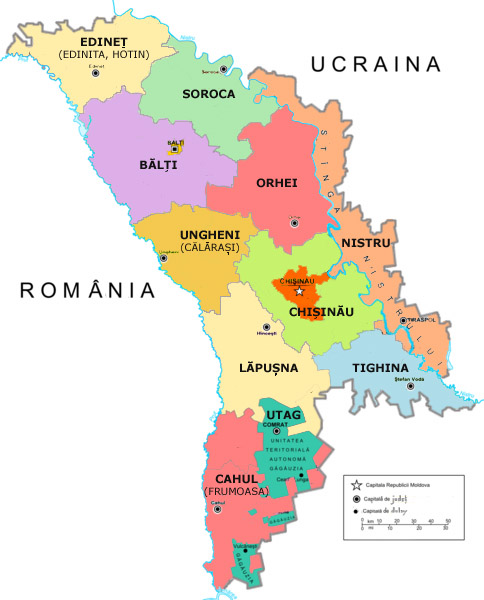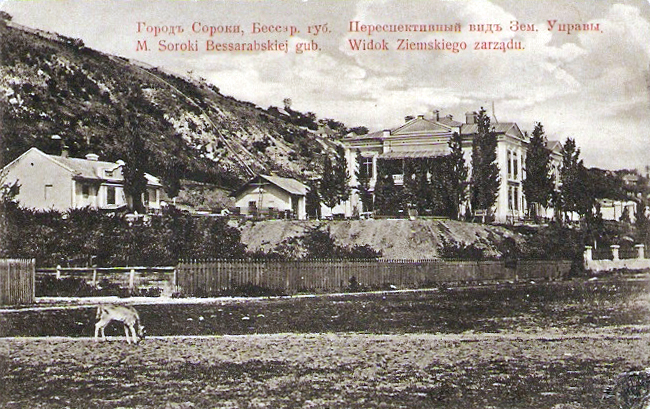|
Counties Of Moldova
{{wikisourcelang, ro, Legea nr. 191 din 12 noiembrie 1998 privind organizarea administrativ-teritorială a Republicii Moldova, Law regarding the division of Moldova into counties, 12 November 1998 Between 1999 and February 2002, Moldova was divided into 12 territorial units, including 1 municipality, 1 autonomous territorial unit, 1 territorial unit, and 9 counties (Romanian: ''județe''; seats in brackets): # Chișinău municipality, surrounded by Chișinău County, but different from it # Bălți County (Bălți) # Cahul County (Cahul) # Chișinău County (Chișinău) # Edineț County (Edineț) # Lăpușna County (Hîncești) # Orhei County (Orhei) # Soroca County (Soroca) # Tighina County (Căușeni) # Ungheni County (Ungheni) # Găgăuzia, autonomous territorial unit (Comrat) # Stânga Nistrului, territorial unit (Dubăsari) In October 1999 a ''Taraclia County'' was split out from the Cahul County; it coincides with the current Taraclia District Taraclia (, ) is a d ... [...More Info...] [...Related Items...] OR: [Wikipedia] [Google] [Baidu] |
Moldova Judete
Moldova ( , ; ), officially the Republic of Moldova ( ro, Republica Moldova), is a Landlocked country, landlocked country in Eastern Europe. It is bordered by Romania to the west and Ukraine to the north, east, and south. The List of states with limited recognition, unrecognised state of Transnistria lies across the Dniester river on the country's eastern border with Ukraine. Moldova's Capital city, capital and largest city is Chișinău. Most of Moldovan territory was a part of the Principality of Moldavia from the 14th century until 1812, when it was Treaty of Bucharest (1812), ceded to the Russian Empire by the Ottoman Empire (to which Moldavia was a Vassal state of the Ottoman Empire, vassal state) and became known as Bessarabia. In 1856, southern Bessarabia was returned to Moldavia, which three years later united with Wallachia to form United Principalities, Romania, but Russian rule was restored over the whole of the region in 1878. During the 1917 Russian Revolution, B ... [...More Info...] [...Related Items...] OR: [Wikipedia] [Google] [Baidu] |
Orhei County (Moldova)
Orhei County was a county (Romanian: ''județ'') in Moldova from 1998 to 2003. It bordered Soroca County, Ungheni County, Bălţi County, Chişinău County, and Transnistria. Its capital was the city of Orhei Orhei (; Yiddish ''Uriv'' – אוריװ), also formerly known as Orgeev (russian: Орге́ев), is a city, municipality and the administrative centre of Orhei District in the Moldova, Republic of Moldova, with a population of 21,065. Orhei .... References Counties of Moldova Statoids.com Counties of Moldova Counties of Bessarabia 1998 establishments in Moldova 2003 disestablishments in Moldova States and territories established in 1998 States and territories disestablished in 2003 {{moldova-geo-stub ... [...More Info...] [...Related Items...] OR: [Wikipedia] [Google] [Baidu] |
Dubăsari
Dubăsari ( ro, Dubăsari , Moldovan Cyrillic alphabet: Дубэсарь) or Dubossary (russian: Дубоссары; yi, דובאסאר; uk, Дубоcсари) is a city in Transnistria, with a population of 23,650. Claimed by both the Republic of Moldova and the Transnistrian Moldavian Republic, the city is under the latter's administration, and functions as the seat of the Dubăsari District. Name The origin of the town name is the plural form of the Romanian archaic word ''dubăsar'' ("boatman"), a derivative of ''dubă'' ("a small wooden boat"), so "Dubăsari" means "boatmen". History Dubăsari is the site of one of the oldest settlements in Moldova, and the Transnistrian region. Stone Age artifacts have been found in the area, and there are several kurgans (presumed Scythian) around the city. First mentions of modern Dubăsari date to the beginning of the 16th century, as a fair populated by Moldavian peasants. The settlement became part of the Russian Empire in 1792, and ... [...More Info...] [...Related Items...] OR: [Wikipedia] [Google] [Baidu] |
Transnistria
Transnistria, officially the Pridnestrovian Moldavian Republic (PMR), is an unrecognised breakaway state that is internationally recognised as a part of Moldova. Transnistria controls most of the narrow strip of land between the Dniester river and the Moldovan–Ukrainian border, as well as some land on the other side of the river's bank. Its capital and largest city is Tiraspol. Transnistria has been recognised only by three other unrecognised or partially recognised breakaway states: Abkhazia, Artsakh and South Ossetia. Transnistria is officially designated by the Republic of Moldova as the Administrative-Territorial Units of the Left Bank of the Dniester ( ro, Unitățile Administrativ-Teritoriale din stînga Nistrului) or as ("Left Bank of the Dniester"). The Council of Europe considers the territory to be under military occupation by Russia. The region's origins can be traced to the Moldavian Autonomous Soviet Socialist Republic, which was formed in 1924 within th ... [...More Info...] [...Related Items...] OR: [Wikipedia] [Google] [Baidu] |
Comrat
Comrat ( ro, Comrat, ; gag, Komrat, Russian and bg, Комрат, Komrat) is a city and municipality in Moldova and the capital of the autonomous region of Gagauzia. It is located in the south of the country, on the Ialpug River. In 2014, Comrat's population was 20,113, of which the vast majority are Gagauzians. History Comrat was first settled as early as 1443, with other sources claiming it was founded in 1789. Nevertheless, the settlement was sparsely populated until the new russian government issued a decree in 1819 to resettle the region with Bulgarians and other nationalities from across the Danube.http://aboutmoldova.md/ro/view_free.php?id=365 (in Romanian) In 1906, the village revolted against the Russian authorities and proclaimed the autonomous (but not independent) Comrat Republic.The village received town privileges in 1952. During the time when the town was part of Moldavian SSR, Comrat's industry was geared toward the production of butter, wine, and rugs, the ... [...More Info...] [...Related Items...] OR: [Wikipedia] [Google] [Baidu] |
Găgăuzia
Gagauzia or Gagauz-Yeri, or ; ro, Găgăuzia; russian: Гагаузия, Gagauziya officially the Autonomous Territorial Unit of Gagauzia; ro, Unitatea Teritorială Autonomă Găgăuzia, ''UTAG''; russian: Автономное территориальное образование Гагаузия, Avtonomnoye territoriaľnoye obrazovaniye Gagauziya, АТОГ (ATUG), is an autonomous territorial unit of Moldova. Its autonomy is ethnically motivated by the predominance in the region of the Gagauz people, who are primarily Orthodox Turkic-speaking people. At the end of World War I, all of the territory of Gagauzia became part of the Kingdom of Romania, before being carved up into the Soviet Union in June 1940. From 1941 to 1944 it was again part of Romania, after which it was incorporated into the Moldavian Soviet Socialist Republic. As the Soviet Union began to disintegrate, Gagauzia declared independence in 1990 as the Gagauz Republic, but was integrated into Moldova in 1994. ... [...More Info...] [...Related Items...] OR: [Wikipedia] [Google] [Baidu] |
Ungheni
Ungheni () is a municipality in Moldova. With a population of 35,157, it is the seventh largest town in Moldova and the seat of Ungheni District. There is a bridge across the Prut and a border checkpoint to Romania. There is another border town with the same name in Romania (Ungheni, Iași), on the other side of the Prut River. History The first historical mention of Ungheni dates to 20 August 1462. A railway between Ungheni and Chișinău was built in 1875 by Russia in preparation for the Russo-Turkish War (1877–1878). After World War II, the rail route through Ungheni became the main connection between the USSR and Romania. Features and attractions Gustave Eiffel bridge In 1876 after the spring flooding of the river Prut, the railway bridge that linked Moldova and Romania was almost destroyed. The Railways Department invited Gustave Eiffel to Bessarabia (Moldova) to redesign and rebuild the bridge. Today, it remains a strategic structure under the supervision of ... [...More Info...] [...Related Items...] OR: [Wikipedia] [Google] [Baidu] |
Ungheni County
Ungheni County ( ro, Județul Ungheni) was a county of Moldova from 1998 to 2003. Its population in 2003 was 260,300. Its capital was Ungheni. It was bordered by the Moldovan counties of Bălți, Orhei, Chişinău, and Lăpușna, and with Romania to the west. See also *Moldavian counties A ''ținut'' (pl. ''ținuturi''; sometimes translated in English as "region", "district" or "municipality"Gerald J. Bobang, ''The emergence of the Romanian national State'', East European Quarterly, 1979. . p. 227.) were the traditional subdivision ... External links Counties of Moldova Statoids.com Counties of Moldova Counties of Bessarabia 1998 establishments in Moldova 2003 disestablishments in Moldova States and territories established in 1998 States and territories disestablished in 2003 {{Ungheni-geo-stub ... [...More Info...] [...Related Items...] OR: [Wikipedia] [Google] [Baidu] |
Căușeni
Căușeni () is a town and the administrative center of Căușeni District, Moldova. Its population at the 2014 census was 15,939, of which 12,056 Moldovans, 1,119 Romanians, 747 Russians, 545 Ukrainians, 204 Bulgarians, 69 Gagauzians, 12 Gypsies, and 1,187 other/undeclared. History The 17th century Assumption of Our Lady Church is the oldest surviving building in the town. It is set more than below ground level and preserves the only medieval fresco in the Republic of Moldova. Executed by Walachian painters in a late Byzantine-Romanian style, the interiors feature religious scenes and iconography in vibrant reds, gold, and blues. At one time it was a vibrant Jewish shtetl. In 1897, 45 percent of the population (1,675) was Jewish, most working in agriculture. Notable people * Bianna Golodryga, journalist at CNN CNN (Cable News Network) is a multinational cable news channel headquartered in Atlanta, Georgia, U.S. Founded in 1980 by American media proprietor Ted ... [...More Info...] [...Related Items...] OR: [Wikipedia] [Google] [Baidu] |
Tighina County (Moldova)
Tighina County was a county (Romanian: '' județ'') in Moldova from 1998 to 2003. It bordered Ukraine, Lăpușna County, Chișinău County, and Transnistria. Its ''de jure'' capital was the city of Tighina, but due to the Transnistria situation, the ''de facto'' capital was Căușeni Căușeni () is a town and the administrative center of Căușeni District, Moldova. Its population at the 2014 census was 15,939, of which 12,056 Moldovans, 1,119 Romanians, 747 Russians, 545 Ukrainians, 204 Bulgarians, 69 Gagauzians, 12 Gypsi .... Tighina County had 93 localities, of which four had city status: Tighina, Căușeni, Căinari, and Ștefan Vodă. References Counties of Moldova Statoids.com Counties of Moldova Counties of Bessarabia 1998 establishments in Moldova 2003 disestablishments in Moldova States and territories established in 1998 States and territories disestablished in 2003 {{moldova-geo-stub ... [...More Info...] [...Related Items...] OR: [Wikipedia] [Google] [Baidu] |
Soroca
Soroca (russian: link=no, Сороки, Soroki, uk, Сороки, Soroky, pl, Soroki, yi, סאָראָקע ''Soroke'') is a city and municipality in Moldova, situated on the Dniester River about north of Chișinău. It is the administrative center of the Soroca District. History The city has its origin in the medieval Genoese trade post of Olchionia, or Alchona. It is known for its well-preserved stronghold, established by the Moldavian prince Stephen the Great (''Ștefan cel Mare'' in Romanian) in 1499. The origins of the name Soroca are not fully known. Soroca (Russian: сорока) means Magpie in Russian. Its location is only a few kilometers from the Moldova–Ukrainian border. The original wooden fort, which defended a ford over the Dniester, was an important link in the chain of fortifications which comprised four forts (e.g., Bilhorod-Dnistrovskyi, then known as Akkerman, and Khotyn) on the Dniester, two forts on the Danube, and three forts on the north border of ... [...More Info...] [...Related Items...] OR: [Wikipedia] [Google] [Baidu] |
Soroca County (Moldova)
Soroca County was a county (Romanian: '' județ'') in Moldova from 1998 to 2003. It bordered Ukraine, and within Moldova, the counties of Edineț, Bălți, and Orhei, and the region of Transnistria. Its capital was the city of Soroca Soroca (russian: link=no, Сороки, Soroki, uk, Сороки, Soroky, pl, Soroki, yi, סאָראָקע ''Soroke'') is a city and municipality in Moldova, situated on the Dniester River about north of Chișinău. It is the administrative .... References Counties of Moldova Statoids.com Counties of Moldova Counties of Bessarabia 1998 establishments in Moldova 2003 disestablishments in Moldova States and territories established in 1998 States and territories disestablished in 2003 {{moldova-geo-stub ... [...More Info...] [...Related Items...] OR: [Wikipedia] [Google] [Baidu] |



